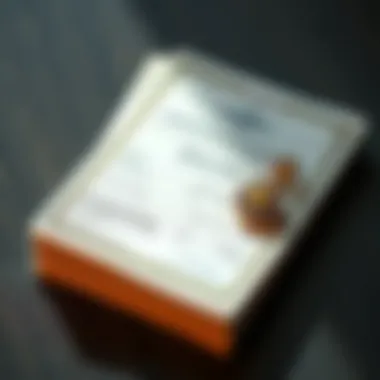Understanding Jewelry Insurance Quotes: A Complete Guide


Intro
Navigating the world of jewelry insurance can feel like stepping into a maze. Many people understand the value of their valuables, but few grasp the intricacies of protecting them with the right insurance. When your precious pieces are on the line, getting the right coverage isn’t just a nice idea; it’s essential. This guide will walk you through everything you need to know about jewelry insurance quotes, ensuring you understand the importance of safeguarding your cherished assets.
Jewelry is more than mere adornment; it often carries sentiment, stories, and significant value. So it’s only logical to protect it properly. But where does one even begin? In this guide, we’ll peel back the layers on jewelry insurance quotes, illustrating their significance, the process behind securing them, and the various elements that play into coverage options.
With a focus on assessing jewelry value and meticulous documentation, readers will come away with the knowledge necessary to make informed decisions. Let’s not dawdle any longer—every second counts when it comes to the safety of your jewelry.
Understanding Jewelry Insurance
Jewelry is more than just an accessory; it carries sentimental and financial value that can be irreplaceable. Thus, understanding jewelry insurance is paramount for anyone who owns valuable pieces. The discussion on jewelry insurance offers insight into not only what coverage is available but also the necessity of protecting one’s assets. It relates to peace of mind, enabling collectors, enthusiasts, and everyday wearers alike to enjoy their treasures without a constant worry of loss or damage.
The Importance of Insuring Jewelry
Insuring jewelry isn’t merely a financial decision; it’s about safeguarding memories, family heirlooms, and personal treasures. Accidents happen, and whether it’s a lost ring or a stolen necklace, the outcome can be devastating without adequate coverage. Furthermore, a proper insurance policy helps in recovering losses not just financially but emotionally as well. Many owners might be surprised to find out that their regular homeowners' policy doesn't cover specific valuable items or comes with restrictive limits. Protecting your jewelry is about ensuring that you can recover the value of your items in the unfortunate event of theft or damage.
What Jewelry Insurance Covers
Jewelry insurance typically protects against various scenarios, including theft, loss, accidental damage, and sometimes even mysterious disappearance. The coverage generally includes:
- Theft: Coverage in case your jewelry is stolen from your home or while you’re out.
- Accidental Damage: If your ring breaks while you’re wearing it, the insurance may help cover repairs.
- Loss: For instances when an item goes missing, policies might cover its replacement.
- Mysterious Disappearance: This less common coverage can help if a piece vanishes from your possession for no clear reason.
It's essential to read the fine print of any policy, as specific exclusions can apply. For instance, some policies may not account for pre-existing damages or might have limitations based on the jewelry’s appraised value.
Types of Jewelry Insurance
When it comes to insuring your jewelry, you have a few options to consider, each with its unique advantages and drawbacks.
Homeowners Insurance
Homeowners insurance often seems like a convenient option for protecting jewelry, as it generally covers personal property within your home. However, this coverage usually has limits – there’s often a cap on how much they will pay for any one item, frequently around $1,500. This can be quite limiting if you possess high-value pieces.
Furthermore, for claims to go through, you'll typically need to show proof of ownership. Thus, while homeowners insurance can be a quick fix, it might not be comprehensive enough for serious collectors or gemstone enthusiasts.
Standalone Jewelry Insurance
Standalone jewelry insurance provides coverage specifically tailored for your jewelry. This type of policy often carries higher limits than homeowners insurance and may include coverage for specific risks such as loss or accidental damage. The main appeal here is its customizability. You can usually adjust the terms based on the individual piece's value.
For those who own intricate or high-value items, standalone policies often provide better peace of mind, although they can come with higher premiums. It's worthwhile to consider this option if you’re serious about safeguarding your collection.
Rider Policies
Rider policies are additions to your existing homeowners' policy that specifically cover listed pieces of jewelry. They fill the gaps left by standard coverage limits. This is a beneficial option for those who want to stick with their current providers while also ensuring that their jewelry has a safety net.
However, adding riders can sometimes be a hassle, requiring appraisals or documentation for each item. Moreover, if you have multiple valuable pieces, managing coverage through riders can become complicated, possibly leaving gaps in protection in the process.
In the end, navigating through the ins and outs of each type ensures that jewelry lovers don’t leave their precious items unprotected. The right insurance can make all the difference when disaster strikes.
The Process of Obtaining a Jewelry Insurance Quote
Grasping how to obtain a jewelry insurance quote is akin to deciphering an intricate puzzle. The importance of this process cannot be overstated, as it equips individuals with the knowledge and tools to protect their treasured possessions. Knowing the ins and outs of obtaining a quote helps prospective policyholders secure the best coverage options suitable for their unique needs.
Being well-informed about the process allows collectors and enthusiasts to feel empowered when discussing their insurance needs with providers. This not only ensures they are adequately covered but also prevents potential misunderstandings later on.


Steps to Acquire a Quote
Getting that all-crucial quote doesn't have to feel like scaling a mountain. It’s really about following a simple set of steps:
- Assess Your Jewelry: Start by reviewing all the pieces you wish to insure. Take note of their age, condition, and any special features.
- Research Insurance Providers: Look into various insurance companies that offer jewelry coverage. Pay attention to their reputation and customer reviews.
- Gather Documentation: Have all relevant documents ready, including appraisals and receipts that can establish the value of your jewelry.
- Request Quotes: Once you have your list of potential insurers, reach out to them for quotes. Be prepared to provide detailed descriptions of your pieces.
- Compare Quotes: After receiving multiple quotes, compare them based on coverage offered, deductibles, and premiums.
- Ask Questions: Do not hesitate to seek clarification about anything you do not understand. Proper communication is key.
- Make a Decision: Choose the policy that best fits your requirements and offers the peace of mind you desire.
Comparing Insurance Providers
In the world of jewelry insurance, not all providers are created equal. Comparing insurance companies hinges on several critical factors:
- Coverage Options: Some insurers may offer more comprehensive plans compared to others. Understand what each policy covers to avoid any surprises.
- Customer Service: Opt for providers known for their reliable customer service. This is vital when you need assistance, especially during challenging times.
- Claims History: Research how each company performs regarding claims. A quick look at online reviews may provide insights into their reputation.
- Pricing Structure: While price shouldn't be the sole factor, it'll certainly play a significant role in your decision-making. Look for the best value for coverage.
Ultimately, take your time to ensure that the insurer aligns well with your needs.
Online versus In-Person Quotes
Should you get your jewelry insurance quote online or face-to-face with an agent? This dilemma often has individuals scratching their heads. Here’s a breakdown:
- Online Quotes:
- In-Person Quotes:
- Convenience: Requesting quotes online can be done from the comfort of your home, making it quick and efficient.
- Broader Options: You're likely to get a wider array of options by browsing multiple sites at once.
- Immediate Results: In many cases, you can receive quotes almost instantly.
- Personal Touch: Meeting an agent face-to-face can offer a more personalized experience.
- Tailored Recommendations: An agent may ask questions that help tailor your policy more effectively to your needs.
- Clear Communication: Easier to clarify any concerns and negotiate terms when you're talking to someone directly.
Ultimately, the choice between online or in-person quotes will depend on your comfort level and personal preferences. Simply be sure to weigh the pros and cons, and go with what feels right for you.
Valuing Your Jewelry for Insurance
Understanding how to accurately value your jewelry is crucial in ensuring that you have the right coverage in place. When it comes to jewelry insurance, undervaluing your assets can lead to significant financial losses during claims. On the flip side, overvaluing them can skyrocket your premiums unnecessarily. Therefore, having a precise valuation helps maintain a balance. This section will explore the key elements of jewelry valuation, the benefits of accurate appraisals, and methods you can use to arrive at a fair market value for your items.
Getting Professional Appraisals
Obtaining a professional appraisal is one of the most reliable ways to evaluate your jewelry. Trained appraisers utilize their expertise to assess factors like the quality of the gem, craftsmanship, and market trends. A professional appraisal typically yields a detailed report, which can serve as evidence for insurance claims. Not only do appraisers provide an objective valuation, but they also help you understand your piece from a historical and artistic perspective.
When selecting an appraiser, look for someone accredited, perhaps associated with the American Society of Appraisers or the International Society of Appraisers.
DIY Valuation Methods
While professional appraisals are ideal, you might find yourself wanting to conduct a preliminary evaluation on your own. There are several DIY methods you can employ to arrive at a ballpark figure.
- Market Research: Check online marketplaces like eBay or Etsy to get a sense of what similar items are selling for.
- Jewelry Valuation Tools: There are apps and websites designed to help enthusiasts estimate the value of their jewelry based on size, quality, and type of stone.
- Retail vs. Resale Value: Understand that retail prices can vastly differ from resale prices. You'd need to consider both.
While DIY methods are convenient, they come with a caveat: they might not be as accurate as relying on a professional. Hence, it's often advisable to follow up with a certified appraisal.
Documenting Your Jewelry
Once you have a valuation in hand, the next step is to properly document your jewelry. Good documentation can aid in filing claims and serves as a record of your asset’s existence and worth.
Photographs and Descriptions
Providing clear photographs and detailed descriptions of your jewelry can substantially enhance your documentation efforts. High-quality images showing various angles of the piece allow for a comprehensive visual reference. This can be especially useful in verifying claims later on. A detailed description, including dimensions, weight, and distinguishing features, can also prevent misunderstandings.
However, there are drawbacks to consider: images can sometimes fail to capture the piece’s true color and brilliance. Therefore, clarity is key.
Certificates of Authenticity


Certificates of Authenticity (COAs) act as a formal validation of your jewelry's qualities—be it the materials used, gem specifications, or craftsmanship. These are issued by manufacturers or certified appraisers. Having a COA enhances your jewelry's legitimacy, which could be beneficial during a claim process. In fact, many insurers prefer or require these certificates.
Nonetheless, acquiring a COA may involve fees and can take additional time, but they provide peace of mind. Being able to present a COA alongside your insurance documentation makes for a more compelling claim should you need to file one later.
"Correctly valuing and documenting your jewelry can protect you from heartache and financial loss in case of an unfortunate event."
By understanding the processes of valuation and documentation, you equip yourself with the knowledge necessary to navigate the complexities of jewelry insurance effectively.
Factors Affecting Jewelry Insurance Quotes
Understanding the factors that influence jewelry insurance quotes is a crucial step for those seeking to protect their valuable possessions. Not only does this knowledge help sharpens awareness around potential costs, but it also aids in making informed decisions regarding the types of coverage available.
Type of Jewelry
The kind of jewelry you own plays a significant role in determining your insurance quote. Precious stones like diamonds, rubies, and sapphires typically carry a higher value than, say, fashion jewelry made from less expensive materials. Insurers often categorize items based on their intrinsic value, rarity, or historical significance. For instance, an antique diamond ring with a rich provenance will likely garner a higher premium than a modern piece.
Moreover, custom-made pieces might need special consideration since their value isn't always reflected in market pricing. When categorizing jewelry for insurance, it’s crucial to provide exact details about the material composition, gemstone quality, and craftsmanship. This comprehensive assessment not only influences the premium rates but also ensures accurate coverage when making future claims.
Location of the Insured
Where you reside can also affect your jewelry insurance quote. Urban settings, generally speaking, often have a higher risk factor associated with theft and loss compared to rural areas. For example, if one lives in a metropolitan city with high crime rates, it’s likely that the insurance policy will factor in those risks, possibly raising premiums. On the other hand, insurance premiums may be lower for clients in more secure or upscale neighborhoods with lower incidents of theft.
Thus, location isn't merely a geographical concern; it's deeply interwoven with perceived risks, making it an essential factor in the equation of insurance pricing.
Security Measures
The precautions taken to safeguard your jewelry significantly impact your insurance premiums. Insurance providers will often assess your home security systems, such as alarms, cameras, and secure storage options like safes. A home equipped with a high-tech, monitored alarm system can lower premiums as it indicates to insurers that the risk of theft or loss is mitigated.
Furthermore, proper storage methods play a vital role. For instance, keeping precious items in a bank vault versus a standard jewelry box could alter your risk profile, leading to more favorable quotes. In essence, demonstrating proactive security measures can translate into savings on your insurance policy.
Claims History
Lastly, your past claims history carries weight in the determination of insurance costs. If you’ve had numerous claims in the past—be it for theft, loss, or damage—insurers may view you as a higher risk, which could inflate your premiums. On the other hand, a clean claims record often leads to better rates and terms.
Insurers also consider the types of claims made. Frequent claims for small amounts may be viewed more negatively than an infrequent claim for a larger item. This inconsistency in claims behavior informs providers of your overall risk and thus influences their pricing models.
Reading and Understanding Your Insurance Policy
When it comes to protecting your jewelry, having an insurance policy is just the start. The real work lies in understanding that policy inside and out. Perspectives vary, yet one thing remains constant: being well-versed in your insurance terms can make a difference in times of need. It’s not enough to just sign on the dotted line and hope for the best. You really need to read the fine print.
Understanding your insurance policy means knowing what your coverage provides, what’s excluded, and how to navigate any potential claims process down the line.
Key Terminology in Policies
The world of insurance often brings along a lexicon that can boggle the mind. Here’s a few key terms that you’ll want to get familiar with:
- Coverage Limit: This is the maximum amount your insurance will pay for a covered loss. If your jewelry is valued at $10,000 but your coverage limit is only $5,000, then that’s all you’ll get back in case of theft or damage.
- Deductible: The amount you must pay out-of-pocket before your insurance kicks in. If you have a $500 deductible and your jewelry suffers $2,000 in damage, you will receive $1,500 from your insurer.
- Rider: An additional provision that can be added to your policy to cover specific items or situations, often not included in standard coverage.
Familiarizing yourself with these terms can enlighten your understanding when dealing with an agent or making a claim.
Exclusions and Limitations
Another crucial aspect of your jewelry insurance policy are the exclusions and limitations. These sections outline what is not covered, which can sometimes be just as significant as the coverage itself. Consider the following:
- Different policies may exclude certain types of loss, like mysterious disappearance. If you can't say how your item was lost, you might have an uphill battle.
- Some natural disasters may also be excluded. Knowing this can help you decide if additional coverage is needed.


"Many don't realize their policy won’t cover loss due to wear and tear, crafting defects, or even certain specific instances of theft."
Understanding these points could save you a world of disappointment and confusion when you need support the most.
Renewal and Coverage Adjustments
Over time, your jewelry collection may grow, complicating coverage needs. This is where renewal and coverage adjustments come into play. Your policy is not just a set-it-and-forget-it deal. Here are a few key considerations:
- Annual Review: Many insurers offer annual reviews to discuss your coverage limits and any changes in value. As the market fluctuates, having this yearly check could be beneficial to both parties.
- Updating Coverage: If you purchase new pieces or if the value of existing items increases, it’s essential to keep your insurer in the loop to ensure adequate coverage. An appraiser can help determine if your policy limit requires an adjustment based on current valuations.
- Claiming Changes: When making a claim, you'll typically have to lend credence to your updated valuations and any changes made to your policy over the year.
Claiming Your Insurance
When the unthinkable happens, the importance of claiming your insurance cannot be overstated. This phase is where coverage transforms from a theoretical safety net into tangible assistance during tough times. Navigating a claim can feel overwhelming––it’s a time when emotions run high as you grapple with loss or damage. Understanding the claims process helps ensure that you’re not left in the lurch.
The Claims Process Explained
Starting the claims process can seem daunting, but breaking it into manageable steps helps orient you. Here’s a straightforward pathway:
- Notify Your Insurer: As soon as the incident occurs, contact your insurance provider to inform them about what happened. Most insurers have a dedicated line for claims.
- Documentation Gathering: This part is crucial. Collect all pertinent documents such as:
- Fill Out Claims Form: Your insurer will provide a claims form. Fill it out accurately; details matter here.
- Submit Your Claim: Send in your paperwork via the preferred method––digital, mail, or in-person. Keeping copies for your records is wise.
- Claim Evaluation: After your claim is submitted, your insurer will review all materials and may send an adjuster to assess the situation.
- Decision Notification: You'll receive a notification regarding the decision on your claim. If approved, you'll learn how and when your compensation will be delivered.
- Photos of the damaged or lost item
- Receipts or appraisals
- Police reports (if applicable)
"Documentation is key; the more thorough your records, the smoother the claim process can be."
Common Reasons for Claim Denials
Insurance claims can be complex, and unfortunately, denials are not rare. Understanding the common pitfalls can assist in avoiding them:
- Insufficient Coverage: Sometimes, folks think their coverage is broader than it is. Always know exactly what your policy covers.
- Late Notification: If you delay informing your insurance about a loss, they may refuse your claim. Timeliness is paramount.
- Lack of Documentation: Inadequate evidence to support your claim can lead to denial. Always have the necessary documents ready.
- Non-Compliance with Policy Terms: Policies often contain specific conditions. Not adhering to these could void your coverage.
Maximizing Your Claim Outcome
Now that we’ve laid out the claims process and common snags, let's discuss maximizing your outcome. Ensuring a smooth claims experience requires preparation and strategy:
- Be Thorough in Documentation: Always provide as much detail as you can. Include photographs, appraisals, and any previous correspondence you have with the insurer.
- Stay Organized: Keep copies of everything you send, along with notes from your conversations with the insurer. This aids if disputes arise.
- Communicate Promptly: Answer any queries from your insurer swiftly. Delays can lead to extended processing times and potential denials.
- Engage an Adjuster: If your claim is substantial, you might consider hiring a public adjuster to help negotiate with the insurance company on your behalf. They understand policies inside and out and can argue your case effectively.
In essence, successfully claiming your jewelry insurance hinges on clarity, communication, and organization. Understanding the process and anticipating common issues can keep you one step ahead.
Culmination: Making Informed Decisions About Jewelry Insurance
Navigating the intricate world of jewelry insurance can often feel like wandering through a labyrinth. However, by consolidating all the knowledge acquired throughout this guide, we can steer clear of the pitfalls and make astute decisions that protect our treasured possessions.
Assessing the Value of Insurance
The value of jewelry insurance extends beyond just financial coverage; it symbolizes the importance of safeguarding emotional and sentimental treasures. To adequately assess this value, one must take several factors into account:
- Current Market Trends: The value of jewelry can fluctuate based on market demand. It's wise to remain updated on the current trends that influence jewelry pricing. For instance, if a certain gemstone or design has surged in popularity, the value of owning such pieces would naturally increase.
- Individual Appraisals: Getting a professional appraisal is a solid way to know how much your items are worth. These experts not only evaluate the material worth but also consider the craftsmanship involved. Detailed appraisals provide essential documentation that can help bolster your insurance claim if needed.
- In-Depth Documentation: Keep an ongoing record of your jewelry. Each piece should have its own photo gallery with descriptors detailing the stone types, metal, and any unique attributes. This systematic documentation will serve you well if you ever need to update your policy or file a claim.
It’s essential to reassess the value of your jewelry regularly, especially after purchasing new pieces or making significant alterations to existing ones. Through careful valuation, you ensure that your insurance policy remains relevant and adequately protective.
Future Considerations
When preparing for the future, several factors merit consideration to navigate the evolving landscape of jewelry insurance:
- Changing Coverage Needs: As your collection grows or changes, so too might your insurance requirements. Providers often adjust their policies. You should periodically review your coverage terms and update your insurer accordingly.
- Policy Renewal Process: Keep an eye on when your policy is up for renewal. Understanding the fine print is vital as there may be new exclusions or alterations in the policy terms. This ensures you don’t end up with gaps in coverage.
- Investment in Security Measures: As the value of your jewelry increases, so does the need for enhanced security measures at home. Whether it’s investing in a larger safe or installing a security system, these advancements can potentially reduce your insurance premiums and enhance your peace of mind.
- Consulting Experts Regularly: Maintain open lines of communication with your insurance provider and appraisal experts. Regular consultations can yield insights into how changes in the insurance industry could affect your policy and coverage.
By adopting a proactive approach towards your jewelry insurance, you can safeguard your assets against unexpected events, ensuring they retain their value and meaning for years to come.
"Knowing the value of what you insur is as crucial as having it insured."
Making informed decisions fosters security in your jewelry investments and peace of mind in your daily life.







